Healing haven
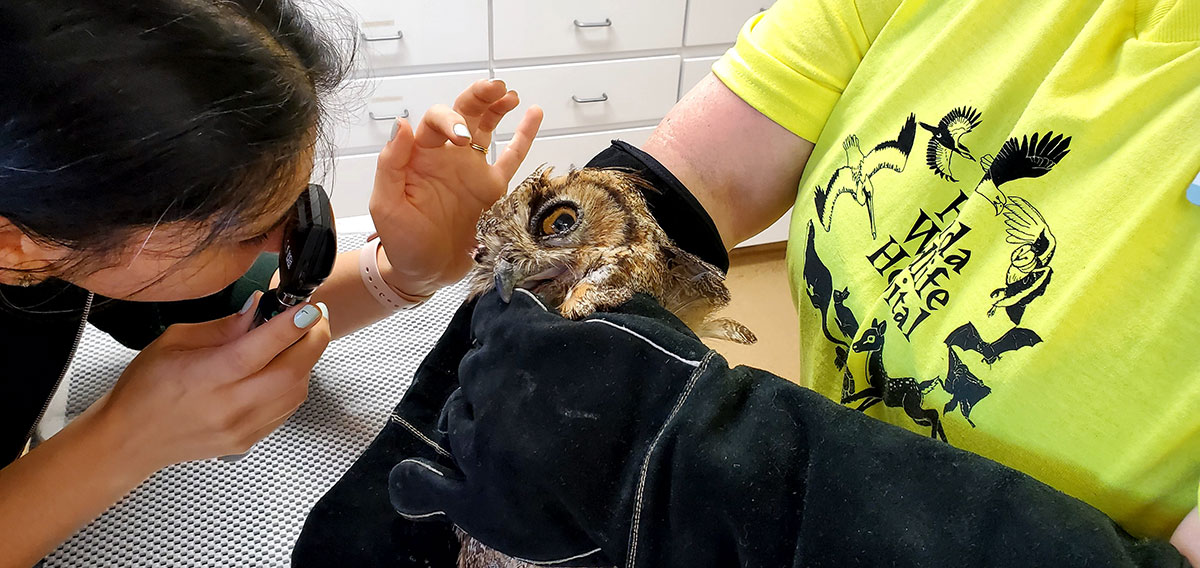
An injured great-horned owl gets a workup at Florida Wildlife Hospital that is celebrating this year a half century of rehabilitating sick and injured wildlife. FLORIDA WILDLIFE HOSPITAL
Hospital provides injured and sick animals a second chance at life
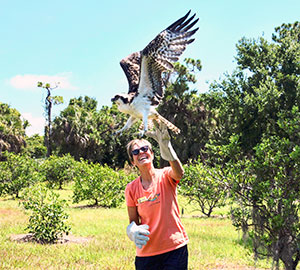
Wildlife Hospital president Josie Quiroz releases an osprey following a stint of rehab at the facility in Palm Shores. BILL MERCER
The unobtrusive blue sign by U.S. 1 in Palm Shores provides little indication of the excellent hospital behind it.
Like other excellent healthcare facilities, this hospital boasts of an ICU and nursery, outdoor spaces where patients can chill out and a corps of compassionate, seasoned staff and volunteers eager to help patients, who, by the way, never have to file insurance claims and are never expected to pay a penny for the care.
There is no bland hospital food here either, for the menu, to put it nicely, is weird … if you were a human. However, for the furry, feathery and scaly patients at Florida Wildlife Hospital, the raw fish, crickets and similar entrees are gourmet fare.
This year marks the hospital’s 50th anniversary of rehabilitating and releasing back to the wild thousands of mammals, birds and reptiles that have run into medical mishaps, primarily as a result of encounters with humans and their ways.
Pelicans entangled in fishing line; baby squirrels orphaned when mom didn’t make it across a road; a great horned owl that didn’t see that power line coming; and gopher tortoises that drew the short stick during a dog/reptile encounter are just a few of the back stories. The list seems endless, particularly when you add the storms and illnesses Mother Nature throws at creatures already struggling to survive a landscape that is constantly shrinking on them.
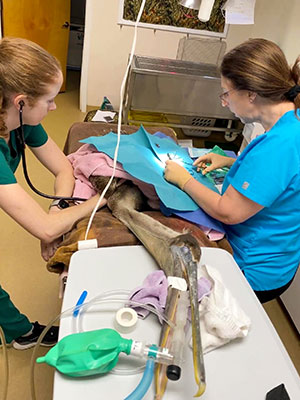
Dan Groover monitors a pelican patient’s vitals while Dr. April Geer, the hospital’s part-time veterinarian, completes a procedure on the bird.
MANY CHALLENGES
In half a century of service, the hospital has faced and surmounted challenges as serious as those facing its patients. Money to pay the bills is never easy to find, for the 5-acre facility operates only because of the generosity of private donors and a few grants. Although the area’s robust growth reduces animal habitat, neither local nor state government has stepped in to do their part.
County commissioners have yet to put the hospital on their radar, but Tracy Frampton, the hospital’s director for the last eight years, is working to change that state of affairs.
Hospital staff and volunteers have always thought outside the box to help patients since 1973, when naturalists Carlton and Gladys Teate launched a makeshift facility to treat injured water birds and other wildlife at wooded property near the Pineda Causeway. The hospital operated from a weatherworn wooden trailer lined with an assortment of hand-me-down cages. In 1998, a generous donor provided for the purchase of the Palm Shores location.
“There was no heat or air conditioning, and the trailer had holes in the ceiling and floor, allowing in rain, rats and insects,” noted Eileen Olejarski, past employee and board member and current volunteer.
Leftovers from the homes of volunteers often fed the patients, a vast difference from meals today.
“Today, patients receive scientifically determined foods and medicine,” Olejarski said.
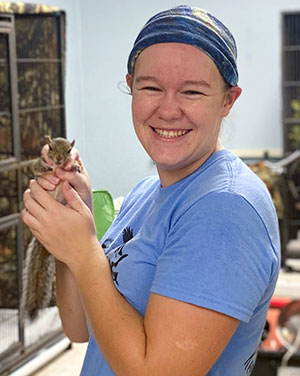
Hailee Rust comforts a baby squirrel. FLORIDA WILDLIFE HOSPITAL
CASES INCREASE
As the county grew, so did the number of patients. Even the pandemic didn’t stop service.
“We closed the building to the public and halted our volunteer program,” Frampton said. “We never stopped accepting patients.”
In 2021, 6,061 patients were admitted to the hospital. Last year, numbers were down from yet another pandemic: HPAF, or the highly pathogenic avian flu, the hospital’s most heartbreaking and discouraging obstacle to date.
“There is no treatment and it is extremely contagious,” Frampton explained. “We had to completely stop rehabilitating birds for a while, and we were receiving calls about mass die-offs and there was nothing we could do to help. It was extremely difficult on the morale of staff and volunteers.”
HPAF remains a threat, but it is not causing the mass kills of last year. Birds are back at the hospital.
“We are managing our avian patients a little differently now, so we are able to rehabilitate and release birds again,” Frampton said.
Like Olejarski, many hospital volunteers sign up for the long run.
Josie Quiroz spends approximately 600 hours a year helping the hospital.
Disturbed by the injured animals she would find driving along South Tropical Trail near her home on Merritt Island, Quiroz decided it was time to do her part for the critters.
“Somebody has to stand up for these animals,” she said. “We’re taking up the green space they need to survive.”
After retiring from the Air Force, she started cleaning cages and progressed to feeding orphaned wild babies at the nursery. Four years ago, she also joined the board and is now president.

The sassiest of all the hospital’s animal ambassadors, Bella the kestrel is a mighty little handful for handlers such as Donna McGill. FLORIDA WILDLIFE HOSPITAL
EDUCATING THE PUBLIC
As one of the volunteers who escort the hospital’s ambassador animals to the many special presentations that are part of an energetic educational program, Quiroz also helps raise awareness of the plight the creatures face on a daily basis.
Ambassador animals and their handlers educate the community on the importance of protecting wildlife and the environment.
All the ambassadors, from tiny one-eyed screech owl Wink to three-legged gopher tortoise Lieutenant Dan, are permanent residents because the extent of their injuries would doom them in the wild.
Since 2016, Brevard Zoo vets visit weekly for the more complicated cases. In celebration of the hospital’s 50th anniversary, an anonymous donor provided funding for the hospital’s first part-time veterinarian, Dr. April Geer.
Rehabilitating and releasing the animals back to their natural habitat is always the end game.
“To hold a magnificent bird like an osprey and see it fly away is awesome,” Quiroz said.
Although it is never easy to humanely end the suffering of an animal that stands no chance of recovery, successes help with daily heartbreak.
Gopher tortoise 22-1151 was found by the side of the road missing a large part of its carapace, but fortunately the thin membrane protecting his internal organs was intact. Brevard Zoo often provides assistance with these difficult cases. The Zoo’s wound vacuum, which treats wounds hard to heal on their own, drew the fluid out of the injury and increased blood flow in the reptile. The tortoise was then transferred to the hospital, where he stayed for five months, receiving regular bandage changing and laser therapy. He’s now back in the wild, probably enjoying snacks of dandelions.
Patient 22-0031 came with pulmonary contusions, lacerations and multiple pelvic fractures. The female bobcat was also in shock. Zoo veterinarians repaired her pelvis and the animal spent four months at the hospital regaining strength and mobility. It was touch and go, but the ending was happy.
“We were overjoyed to see her running free once again,” said Frampton. “We’re in the business to help animals and to keep wildlife wild.”
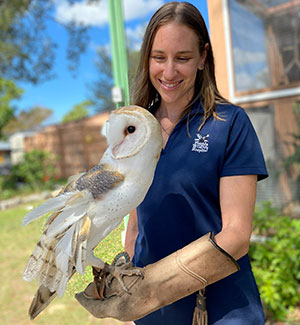
Animal ambassador Corey and handler Lindsay Mayer help raise awareness of the plight of local wildlife. The barn owl is missing its right wing and cannot be released back to the wild.
Want to Help?
Wish List: Wish lists for Amazon, Chewy, Walmart and Chris’ Squirrels can be found at floridawildlifehospital.org, where monetary gifts can also be made. Items run the gamut and include cracked corn, Esbilac powder milk replacer, paper towels, laundry detergent, gently used linens without holes, pecans and walnuts in the shell.
Volunteer: Volunteers, who must be 16 or older, are always VIPs at Florida Wildlife Hospital. Volunteers commit to working at least two 3½-hour shifts a month, at least three months out of the year. Volunteer group projects are also available. Training is provided.
Open House: As part of the 50th anniversary celebration, the hospital is offering behind-the-scene tours of the facility on May 16, June 20, July 18 and Aug. 15. Tickets are $10 for members and $15 for nonmembers. Call 321.254.8843 to make reservations. The hospital is at
4560 North U.S. 1, Palm Shores.

Maria Sonnenberg
Maria is a prolific writer and proofer for Space Coast Living and an adjunct professor at Florida Institute of Technology’s Nathan M. Bisk College of Business. When not writing, teaching or traveling, she can be found waging a one-woman war against her lawn and futilely attempting to maintain order among the chaos of a pack of extremely clueless wirehair dachshunds and an angst-driven basset hound.




